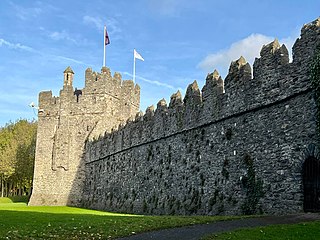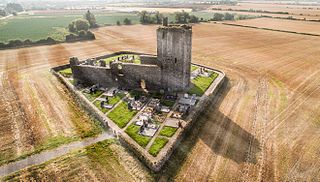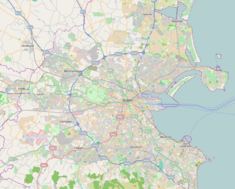
Swords in County Dublin, the county town of the local government area of Fingal, is a large suburban town on the east coast of Ireland, situated ten kilometres north of Dublin city centre. It is the eighth largest urban area in Ireland, with a population of 40,776 as of the 2022 census. The town was reputedly founded c. AD 560. Located on the Ward River, Swords features Swords Castle, a restored medieval castle, a holy well from which it takes its name, a round tower and a Norman tower. Facilities in the area include the Pavilions shopping centre, one of the largest in the Dublin region, a range of civic offices, some light industries, the main storage facility and archive of the National Museum of Ireland and several parks. Dublin Airport is located nearby.

Fingal is a county in Ireland. It is in the province of Leinster and is part of the Eastern and Midland Region. It is one of three successor counties to County Dublin, which was disestablished for administrative purposes in 1994. Its name is derived from the medieval territory of Scandinavian foreigners that settled in the area. Fingal County Council is the local authority for the county. In 2022 the population of the county was 330,506, making it the second most populated council in Dublin and the third most populous county in the state.

Howth is an affluent peninsular village and outer suburb of Dublin, Ireland. The district as a whole occupies the greater part of the peninsula of Howth Head, which forms the northern boundary of Dublin Bay, and includes the island of Ireland's Eye, which holds multiple natural protection designations.

Skerries is a coastal town in Fingal, in the north of County Dublin, Ireland. Skerries was historically a fishing port and later a centre of hand embroidery. These industries declined in the early 20th century, however, and it became both a resort town and a commuter town for Dublin City, located approximately 30 km (19 mi) to the south. Offshore from the town are several islands, one of which is a nature reserve, Rockabill.

Swords Castle is an early medieval castle located in Swords, Dublin. Originally built for the Archbishops of Dublin in the early 13th century near the Ward River, some of the castle estate had fallen into disrepair by the 14th and 15th centuries. At least partially occupied through the 16th and 17th centuries, the castle was used as a place of rendezvous by Anglo-Irish Catholic families during the 1641 Rebellion. The site was afforded protection as a national monument and placed under the guardianship of the Office of Public Works in the early 20th century. As of the late 20th and early 21st century, the site was subject to a program of "long-term phased restoration", and is partially opened for tours. The site is listed on Fingal County Council's Record of Protected Structures.

Santry is a suburb on the northside of Dublin, Ireland, bordering Coolock, Glasnevin, Kilmore and Ballymun. It straddles the boundary of Dublin City Council and Fingal County Council jurisdictions.
Earl of Fingall and Baron Fingall were titles in the Peerage of Ireland. Baron Fingall was a title in the Peerage of the United Kingdom. The seat of the title-holders was, from its establishment until 1953, Killeen Castle in County Meath, Ireland, and there was an ongoing close relationship with the related Plunkett family of Dunsany, and with the Viscounts Gormanston, with whom they intermarried. Around 1426, Christopher Plunkett was created Baron Killeen: his seven sons founded five separate branches of the Plunket family, including the Plunkets of Dunsany, Rathmore and Dunsoghly. He also had a daughter Matilda, who became celebrated as "the bride of Malahide", when her first husband, Thomas Hussey, Baron Galtrim, was reputedly murdered on their wedding day.

Naul, is a village, townland, and civil parish at the northern edge of the traditional County Dublin in Ireland. The Delvin River to the north of the village marks the county boundary with County Meath. Naul civil parish is in the historic barony of Balrothery West.
John Garvey (1527–1595) was an Irish Protestant Bishop of Kilmore and Archbishop of Armagh.
Sir Thomas Luttrell was a wealthy Anglo-Irish landowner of the sixteenth-century Irish Pale. He was also a distinguished lawyer and judge who held the offices of King's Serjeant, Solicitor General for Ireland and Chief Justice of the Irish Common Pleas.
Patrick Barnewall was a leading figure in the Irish Government of the 1530s and 1540s. He owed his position largely to his close links with Thomas Cromwell. He sat in the Irish House of Commons as MP for County Dublin, and held the offices of Solicitor General for Ireland and Master of the Rolls in Ireland. Today he is mainly remembered for his role in founding the King's Inns. He belonged to a junior branch of the family of Lord Trimlestown: his own descendants held the title Viscount Barnewall of Kingsland.
Nicholas St. Lawrence, 9th Baron Howth (c.1550–1607) was a leading member of the Anglo-Irish nobility in the late sixteenth and early seventeenth centuries. Despite openly professing his Roman Catholic faith, he enjoyed the trust of Elizabeth I and of successive Lord Deputies of Ireland, and was even forgiven by the English Crown for signing a petition protesting against the enforcement of the Penal Laws.
Jenet Sarsfield, Baroness Dunsany was an Anglo-Irish noblewoman who lived in Dublin during the Tudor era. She is chiefly memorable for having married no less than six husbands.
Sir John Plunket was an Irish politician and judge of the Tudor era who held the office of Lord Chief Justice of Ireland. He was also a member of the Privy Council of Ireland and was regarded by three successive English monarchs as a valued servant of the Crown. He was noted for his integrity, but was criticised for remaining in office when old age and illness had made him unfit for his judicial duties. He was also notable as the fifth of the six husbands of Jenet Sarsfield.
Sir Thomas Fitz-Christopher Plunket (c.1407–1471) was a leading Irish lawyer and judge of the fifteenth century who held office as Lord Chief Justice of Ireland. He was an ancestor of the Duke of Wellington in the female line. His second marriage to the heiress Marian Cruise inspired the ballad The Song of Mary Cruys.
Sir Thomas Plunket (c.1440–1519) was a wealthy Irish landowner, lawyer and judge in fifteenth-century and early sixteenth-century Ireland. He held office as Chief Baron of the Irish Exchequer and Chief Justice of the Irish Common Pleas. After the change of the English royal family in 1485, his loyalty to the new Tudor dynasty was deeply suspect, and he was involved in two attempts to put a pretender on the English throne. On each occasion he was disgraced, fined and removed from office; yet he had sufficient political influence to ensure his return to favour and high office.

Baldongan Church, also called Baldungan Castle, is an ancient ruined church and National Monument near Skerries, County Dublin, Ireland.
Sir Robert Dillon of Newtown near Trim was an Irish judge of the Tudor era. He served as Chief Justice of the Irish Common Pleas for more than twenty years, despite repeated calls for his removal on the grounds of age and ill health.

Saint Margaret's is a civil parish and townland in the historical barony of Coolock in County Dublin, Ireland. Rivermeade, a housing estate of 175 homes which is treated as a separate census town, is located between Saint Margaret's and the Ward River. Dublin Airport is also nearby.










